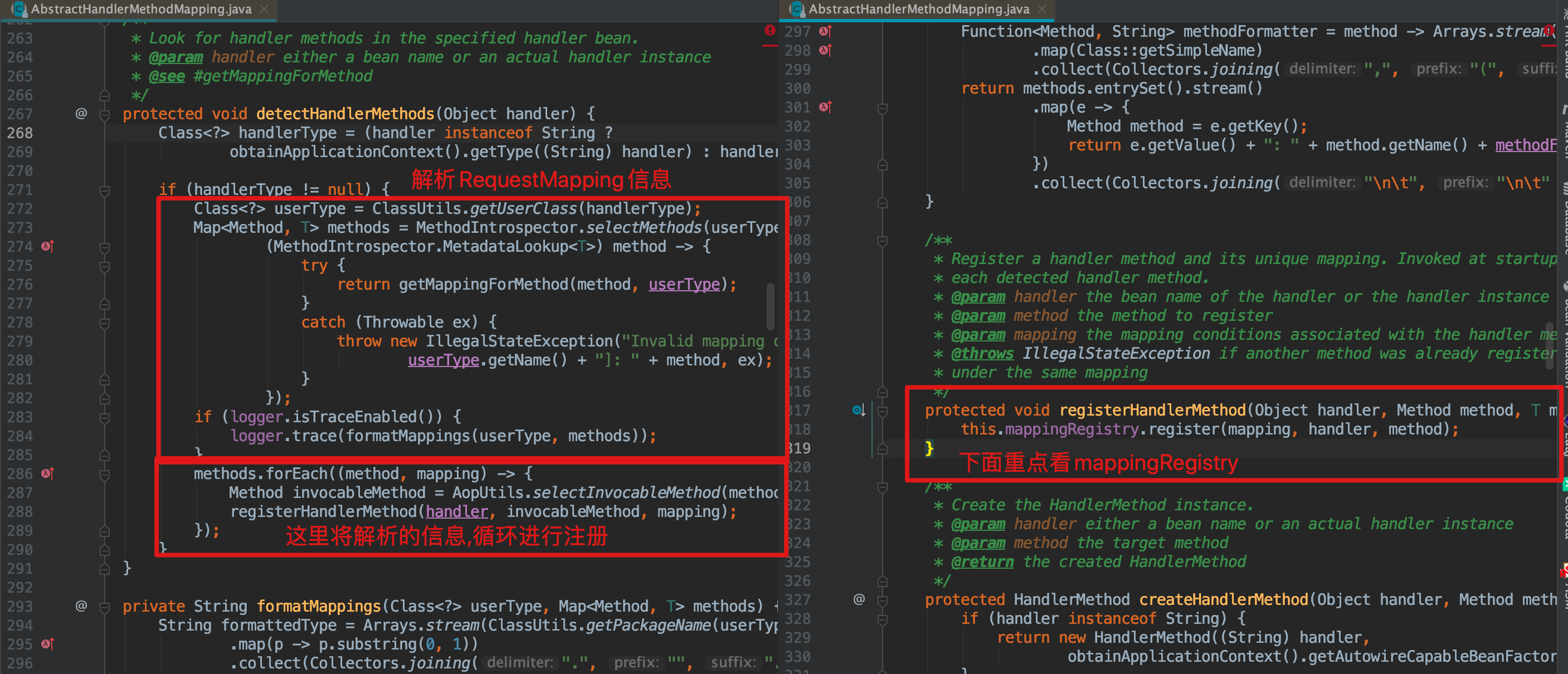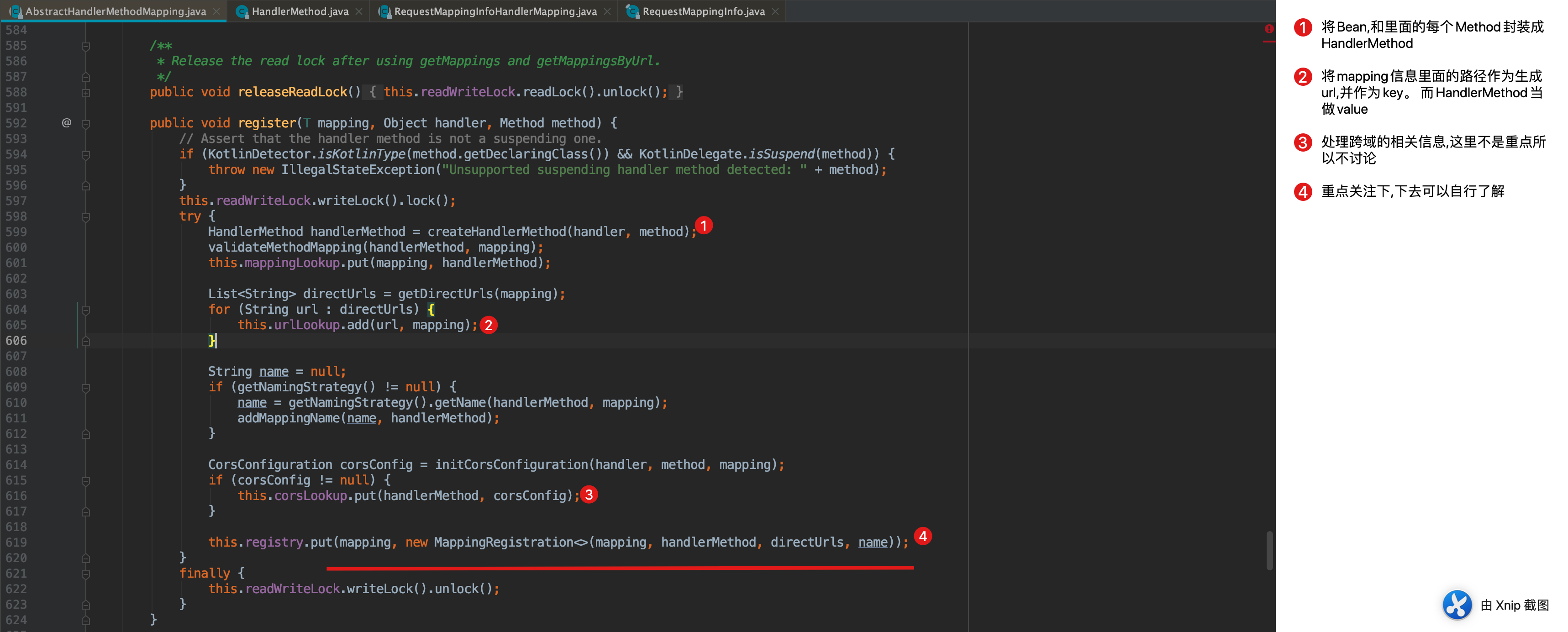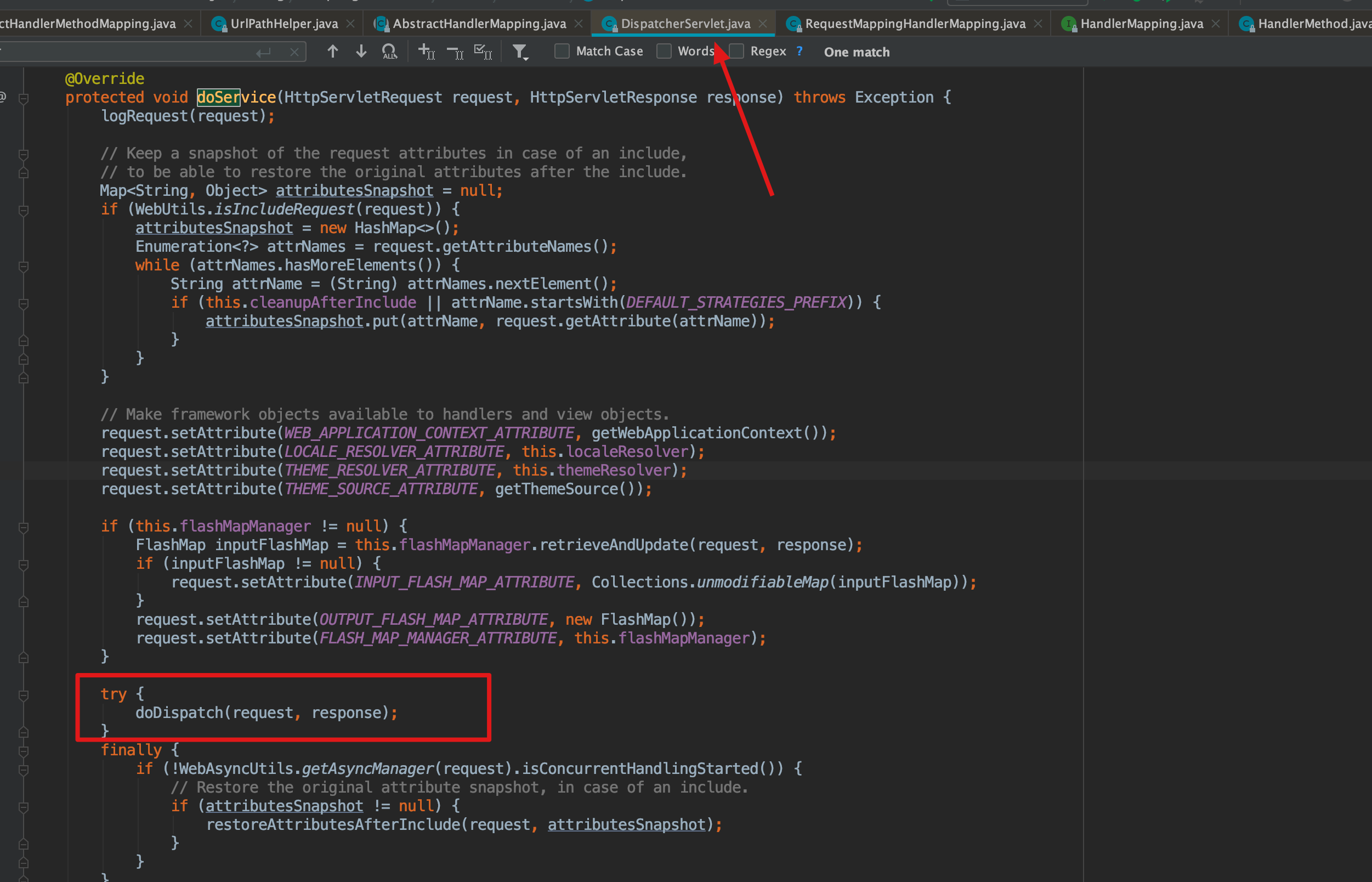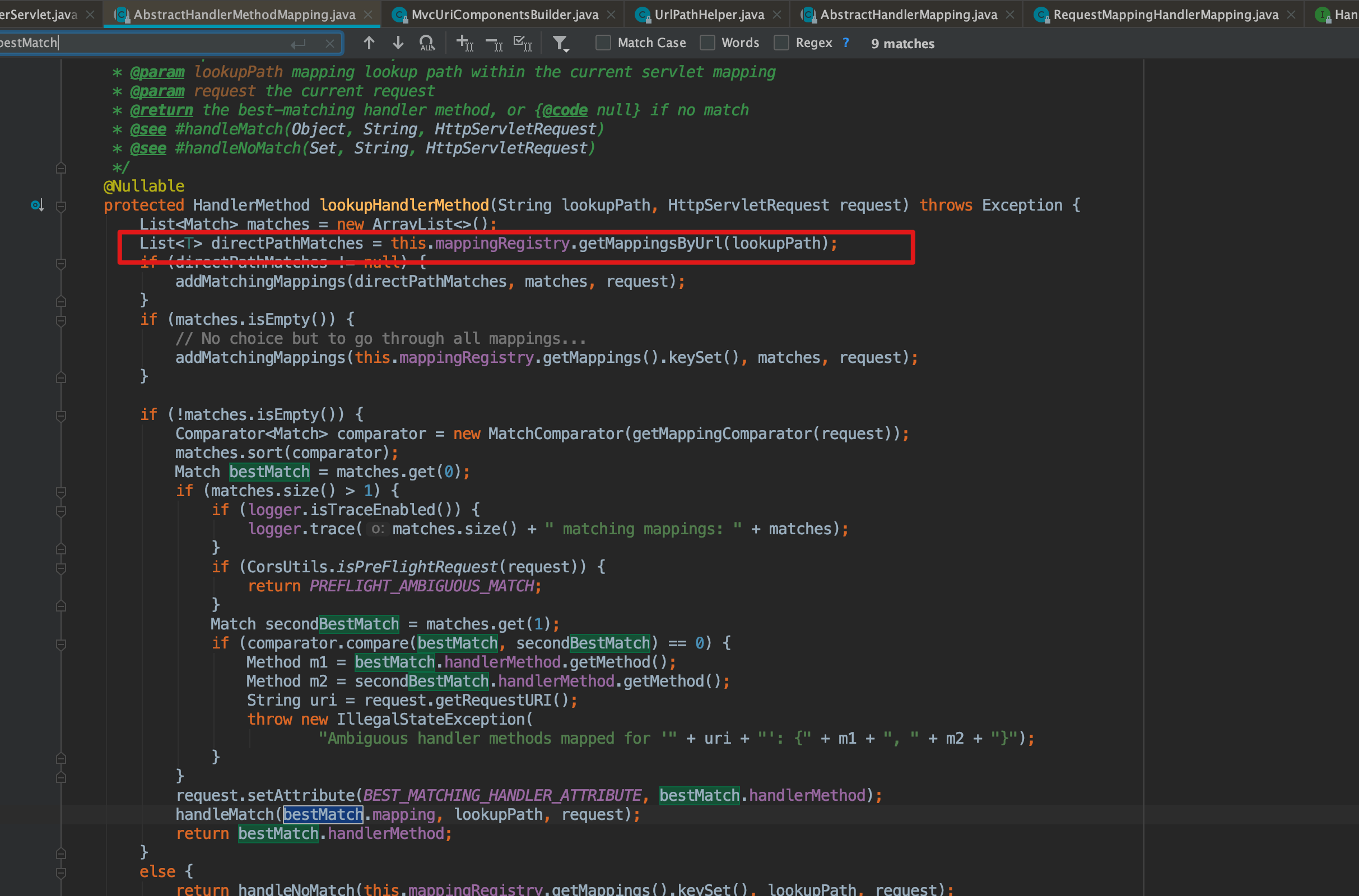Web接口资源是如何保存起来的?
# 前言
在我们使用 SpringBoot 开发中,我们定义一接口是下面这样的
@RestController
public class UserController{
@GetMapping( name = "/getUserName")
public String getUserName(){
return "Hello World";
}
}
2
3
4
5
6
7
8
这时候我们思考一个问题,我们在浏览器上只输入了一个URL地址,怎么就能访问到这个接口的呢?于是乎就引出了 今天我们要讨论的话题。Spring中的Web接口资源是如何保存起来的?
# 一、Spring中的Web接口资源是如何保存起来的?
在我们学习之前我们可以先自己来进行思考一下。处理逻辑是什么样的?
- Spring容器解析
@RequestMapping注解。当然这个注解又派生了其他的注解比如。
@Target(ElementType.METHOD)
@Retention(RetentionPolicy.RUNTIME)
@Documented
@RequestMapping(method = RequestMethod.POST)
public @interface PostMapping {}
@Target(ElementType.METHOD)
@Retention(RetentionPolicy.RUNTIME)
@Documented
@RequestMapping(method = RequestMethod.PUT)
public @interface PutMapping {}
@Target(ElementType.METHOD)
@Retention(RetentionPolicy.RUNTIME)
@Documented
@RequestMapping(method = RequestMethod.GET)
public @interface GetMapping {}
@Target(ElementType.METHOD)
@Retention(RetentionPolicy.RUNTIME)
@Documented
@RequestMapping(method = RequestMethod.DELETE)
public @interface DeleteMapping {}
2
3
4
5
6
7
8
9
10
11
12
13
14
15
16
17
18
19
20
21
22
23
- 我们猜测Spring源码中一定会对
@RestController和@Controller标记的类,里面的每个 Method进行处理,判断是否包含了上面的注解。注解那么多Spring肯定不会这样一个一个去处理。我们可以看到 上面的注解都使用了@AliasFor注解。其中奥妙就在这里。看下面例子代码。 - 我们猜测Spring肯定对这些Method判断是否有
@RequestMapping有注解。
# 1. @AliasFor使用
@RestController
public class PostController {
@ApiOperation(value = "查询Bbs所有文章")
@PostMapping(value = "/query/bbs/posts", produces = MediaType.APPLICATION_JSON_VALUE)
public Result<PostAllResponse> queryBbsPostAll(@RequestBody PostAllSelectRequest postAllSelectRequest) {
return postBiz.queryBbsPostAll(postAllSelectRequest);
}
public static void main(String[] args) {
Method queryBbsPostAll = ClassUtils.getMethod(PostController.class, "queryBbsPostAll",PostAllSelectRequest.class);
PostMapping annotation = AnnotationUtils.findAnnotation(queryBbsPostAll, PostMapping.class);
///query/bbs/posts
System.out.println(StringUtils.arrayToCommaDelimitedString(annotation.value()));
//application/json
System.out.println(StringUtils.arrayToCommaDelimitedString(annotation.produces()));
//是否包含RequestMapping: true
System.out.println("是否包含RequestMapping: "+AnnotatedElementUtils.hasAnnotation(queryBbsPostAll,RequestMapping.class));
RequestMapping mergedAnnotation = AnnotatedElementUtils.getMergedAnnotation(queryBbsPostAll, RequestMapping.class);
///query/bbs/posts
System.out.println(StringUtils.arrayToCommaDelimitedString(mergedAnnotation.value()));
}
}
2
3
4
5
6
7
8
9
10
11
12
13
14
15
16
17
18
19
20
21
22
23
24
25
可以看到只要使用下面代码就能把被@PostMapping等等的注解都涵盖了。
System.out.println("是否包含RequestMapping: "+AnnotatedElementUtils.hasAnnotation(queryBbsPostAll,RequestMapping.class));
RequestMapping mergedAnnotation = AnnotatedElementUtils.getMergedAnnotation(queryBbsPostAll, RequestMapping.class);
2
# 2. 解析请求Method
AbstractHandlerMethodMapping 实现 InitializingBean。在当前 Bean初始化时候会执行
afterPropertiesSet -> initHandlerMethods
从这里开始解析Web资源类的信息。请小伙伴们看下面的截图,截图中源码已经把类名也截上了,方便小伙伴们自己在根据截图看一遍源码。
public abstract class AbstractHandlerMethodMapping<T> extends AbstractHandlerMapping implements InitializingBean {
@Override
public void afterPropertiesSet() {
initHandlerMethods();
}
/**
* Scan beans in the ApplicationContext, detect and register handler methods.
* @see #getCandidateBeanNames()
* @see #processCandidateBean
* @see #handlerMethodsInitialized
*/
protected void initHandlerMethods() {
for (String beanName : getCandidateBeanNames()) {
if (!beanName.startsWith(SCOPED_TARGET_NAME_PREFIX)) {
processCandidateBean(beanName);
}
}
handlerMethodsInitialized(getHandlerMethods());
}
}
2
3
4
5
6
7
8
9
10
11
12
13
14
15
16
17
18
19
20
21
22
RequestMappingHandlerMapping解析Method上的RequestMapping信息

isHandler 方法判断是否是web资源类。 当一个类被标记了 @Controller 或者@RequestMapping。 注意 @RestController 是@Controller的派生类。所以这里只用判断 @Controller 或者@RequestMapping就行了。

detectHandlerMethods方法就是真正开始解析Method的逻辑。通过解析Method上的 @RequestMapping或者其他派生的注解。生成请求信息。
注意这个请求信息里面也是有很多逻辑的不过不是本篇讨论的重点,就不说了。稍微提一下。根据规则来匹配url逻辑就在这里面。

这里我们能看到源码里拿到了Method并拿到了执行这个Method的实例Bean。在这里封装成了HandlerMethod并注册到了MappingRegistry中。

在注册的过程中把RequestMapping中的路径信息同事也放到一个urlLookup中。key是url,value是Mapping信息。

到这里其实我们就把本篇的议题就说明清楚了。下面我们在看下SpringWeb是如何将http请求信息路由到具体的HandlerMethod的吧。
# 3. 最后串一下流程
看了前面的截图,我们知道Spring是如何把这些Web资源信息给保存起来的了。然后就看是DispatcherServlet的逻辑了。
首先DispatcherServlet 是一个Servlet。Servlet相信大家都都知道就不重点说原理。 我们直接看
doService -> doDispatch 方法

根据请求路径,找到从Mapping信息,然后根据Mapping信息匹配到具体的HandlerMethod。 ok本篇内容就到这里。谢谢大家。




